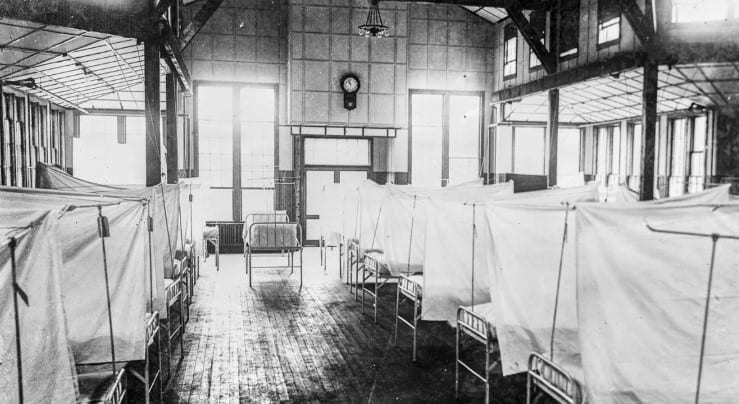Over the last three years, the Covid-19 pandemic has influenced the political debate and elections across the globe. This column seeks to broaden the debate by shifting the focus from the impact of health crises on incumbent governments to their effects on the broader political landscape. In the context of Weimar Germany, constituencies that experienced a more severe outbreak of the Spanish flu witnessed a notable shift in voting towards left-wing parties. These voters gravitated towards parties that had previously demonstrated expertise in public health matters, as opposed to merely penalising local incumbents.
The Covid-19 pandemic has cast a spotlight on public health topics across the world. As we grapple with the persisting potential of intense epidemics, it is crucial to gain a comprehensive understanding of their impact on the political economy. Much scholarly attention has been devoted to studying the consequences of the implemented lockdown policies – or their absence – for incumbent governments.
Depending on the effectiveness of these policy responses, citizens either expressed dissatisfaction with their government or rallied together, united by a common threat, supporting their government. In the early stages of the pandemic, Herrera et al. (2020) suggested that the approval rates of governments worldwide declined when they failed to control the virus. In Europe, citizens responded favourably to their incumbent government if it relied on scientific expertise (Daniele et al. 2020). Using outcomes from presidential election, Baccini et al. (2021) show that the incumbent lost more votes in US counties more severely affected by Covid-19. Similarly, during French municipal elections, regions subjected to stringent lockdown measures witnessed an upswing in support for the incumbent (Giommoni and Loumeau 2020).
Looking for answers in the long history of epidemics across the world, Arroyo Abad and Maurer (2021) study the 1918 Influenza pandemic in the US, and estimate that poor health outcomes had negative, albeit modest, effects on incumbent parties. In light of our recent study (Bauernschuster et al. 2023), this column argues that exploring pandemics’ effects on political competition at large beyond the impact on incumbent parties offers valuable new insights. In our paper, we analyse how the 1918 Influenza pandemic influenced voting in the Weimar Republic.
Historical background
In 1918, WWI had not yet ended when a mysterious pandemic spread and eventually killed an estimated 39 million people across the globe (Barro et al. 2020). Initially starting at Fort Riley, Kansas, the virus soon reached Europe through troop movements. The US closed theatres and museums, and some cities responded with lockdowns, thereby effectively flattening the mortality curve (Correia et al. 2022).
The situation was different in the German Empire, where the second, deadly wave of the virus coincided with the Hundred Days Offensive, the final phase of the war on the Western Front. Politicians took no action out of concern for the morale of the people. Censorship prevailed, and the press did not report the outbreak at first; coverage was minimal in the second wave in October and November 1918. The war and the peace negotiations dominated the news at the time. Yet, the pandemic was quite salient for the population. According to estimates, the Spanish flu killed more than 400,000 people in Germany within just a few months – slightly more than German military casualties during the same year (Barro et al. 2020). The pandemic had an impact on everyday life, not only because of the numerous deaths, but also because many people were unable to work due to illness, causing delays in production processes and public life.
Empirical approach
To study the impact of the influenza on the political landscape, we have to measure its intensity at the local level. In absence of a direct measure of Spanish flu deaths, we used administrative constituency-level mortality data from 1904 to 1918, predict excess mortality in 1918, and econometrically purge this measure from military casualties (see Figure 1). Plausibility checks at the city level, where data on causes of death are available, show that the resulting variable indeed picks up Spanish Flu mortality.
Figure 1 Estimated Spanish flu mortality across constituencies


Notes: The map depicts Spanish flu mortality in 1918 across constituencies. Spanish flu mortality in 1918 is excess mortality in 1918 purged of military deaths in 1918 per 1,000 individuals in 1910. Yellow dots indicate the location of the cities included in the city-level analysis.
Using excess mortality due to the Spanish flu as a measure of the local intensity of the pandemic, we compare the voting behaviour between strongly and weakly affected constituencies in a dynamic difference-in-differences model over the period 1893 to 1939. This model allows us to factor out constant regional differences in voting behaviour as well as general election specific effects that applied to all regions. Additionally, we control for changes in the electorate across constituencies; this is crucial since from the last Reichstag election before the outbreak of the Spanish flu in the German Empire in 1912 to the first election thereafter in 1919 in the Weimar Republic, the voting age was lowered and women’s suffrage was introduced. Moreover, to make the voting data comparable over time, we work with constituency boundaries from the Empire and group parties into three larger groups, the left-leaning bloc, the centrist bloc, and the right-leaning bloc.
Main results
We find that constituencies with higher and lower influenza mortality follow a similar voting trend in the entire pre-pandemic period from 1893 to 1912, the last election before the Spanish flu. Only after the Spanish flu, we observe a significant increase in vote shares for the left-leaning bloc in constituencies with higher influenza mortality. If the number of influenza deaths increases by two per 1,000 population, which corresponds to an increase of about 30% of the average influenza mortality, the left-wing vote share increases by 8.1% compared to 1912. This effect remains stable until 1933 (see Figure 2).
Figure 2 Event study for left-wing vote share


Notes: The figure plots coefficients estimated from an event-study specification with 95% confidence intervals. The dependent variable measures left-wing vote shares at the constituency level for 14 elections between 1893 and 1933. The main explanatory variable is predicted Spanish flu mortality in 1918 as shown in Figure 1, interacted with election-fixed effects. Demographic controls and war-related, controls interacted with time-fixed effects included. The omitted reference election is 1912. Standard errors are clustered at the constituency level. The grey-shaded area marks the pandemic.
We provide a rich set of validity and robustness checks to rule out confounding factors. One concern might be that the shift to the left is driven by increased poverty or inequality during WWI. We use data on wealth and income distribution to calculate Gini coefficients, a statistical measure of inequality, and use data on the share of the poor. However, the inclusion of these control variables in our model does not change the findings. We also examine trends in infant mortality, as this is often considered an important indicator of precarious living conditions, such as food shortages. However, we do not find that infant mortality trends are different in constituencies with higher or lower influenza mortality before 1918. Moreover, data on city-level causes of death show that our effects are indeed driven by mortality due to respiratory diseases, the very death category in which influenza deaths are included. Furthermore, we do not find even remotely similar effects for excess mortality from the war years before 1918, nor for excess mortality in 1918 that is not explained by the Spanish flu. Thus, we conclude that the political shift to the left was indeed caused specifically by the Spanish flu.
Mechanisms
Political science often attempts to explain voting behaviour by arguing that voters either reward incumbents for good policies or punish them for poor ones. However, this paradigm does not seem to hold true in our context. Our data show that winners of pre-Influenza elections do not exhibit any systematic increase or decrease in the likelihood to garner votes in response to the Spanish flu. Another conceivable scenario involves protest votes favouring extremist parties. Yet, our analysis can dismiss this notion as well, since we find no evidence of increased polarisation in more affected constituencies. Rather, an extended analysis, in which we break down the left bloc, shows that the moderate left, represented by the SPD, gains most of the votes. The Communist Party, instead, witnesses a decline in votes. Finally, we do not find evidence that our effect on left-wing votes can be explained by economic hardship and inequality due to the Spanish flu (Galletta and Giommoni and Galletta) driving people to vote for the left.
The most plausible explanation for our findings aligns with the ‘issue ownership’ theory from political science (see, for instance, Budge and Farlie 1983 and Petrocik 1996). According to this theory, parties that lay claim to a specific issue and effectively signal their expertise in it tend to receive more votes when the issue becomes salient among voters. The pandemic made health irreversibly a public issue instead of a private affair and parties that historically engaged with this topic were able to capitalise on their expertise. The SPD’s success after 1918 probably lies in its establishment and ownership of health as a prominent public concern—a stance that predates the Spanish flu outbreak. With its focus on the conditions of the working class, Social Democrats had health on their agenda early on and were strongly involved in the self-governing bodies of the health insurance funds. It is a historical irony that the SPD, having initially vehemently criticized Bismarck’s introduction of compulsory health insurance in 1884 as an attempt to sway the working class, gained credit for this ground-breaking social policy in later years. Our research provides another finding in support of the ‘issue ownership’ theory: analyses indicate that the liberals, a party that counted numerous physicians among its members and supported the social hygiene movement, also managed to capitalise on the pandemic’s political implications.
Source : VOXeu





